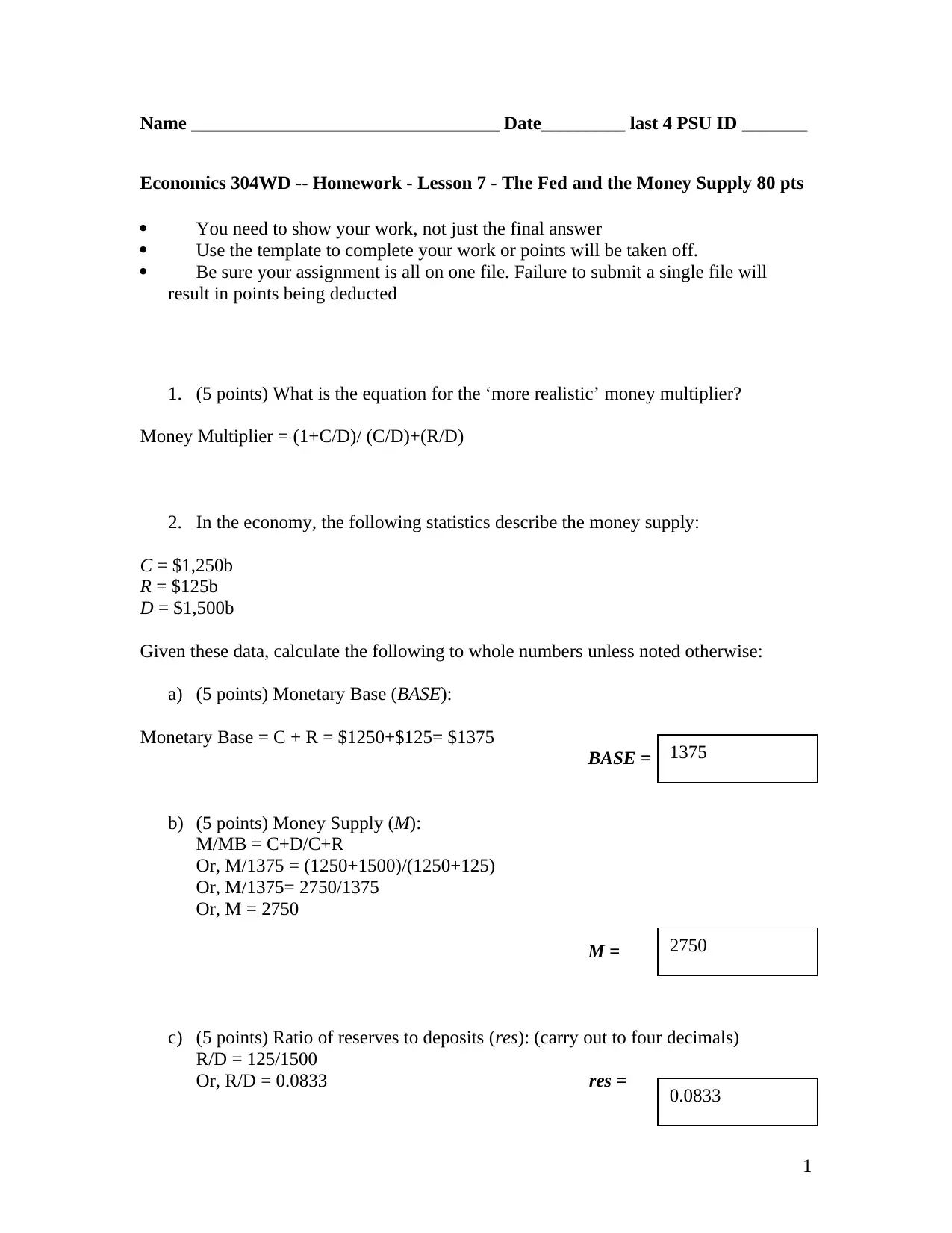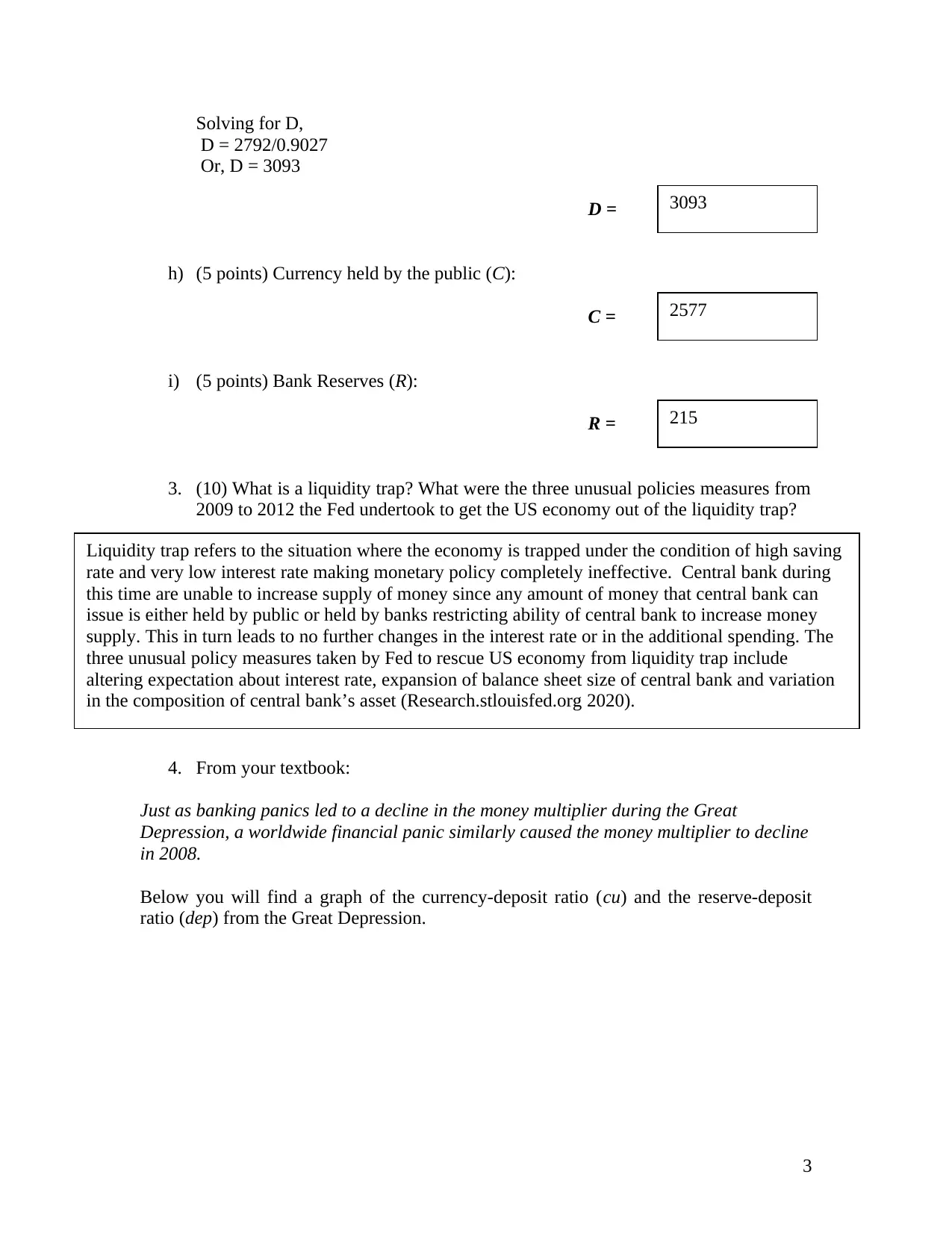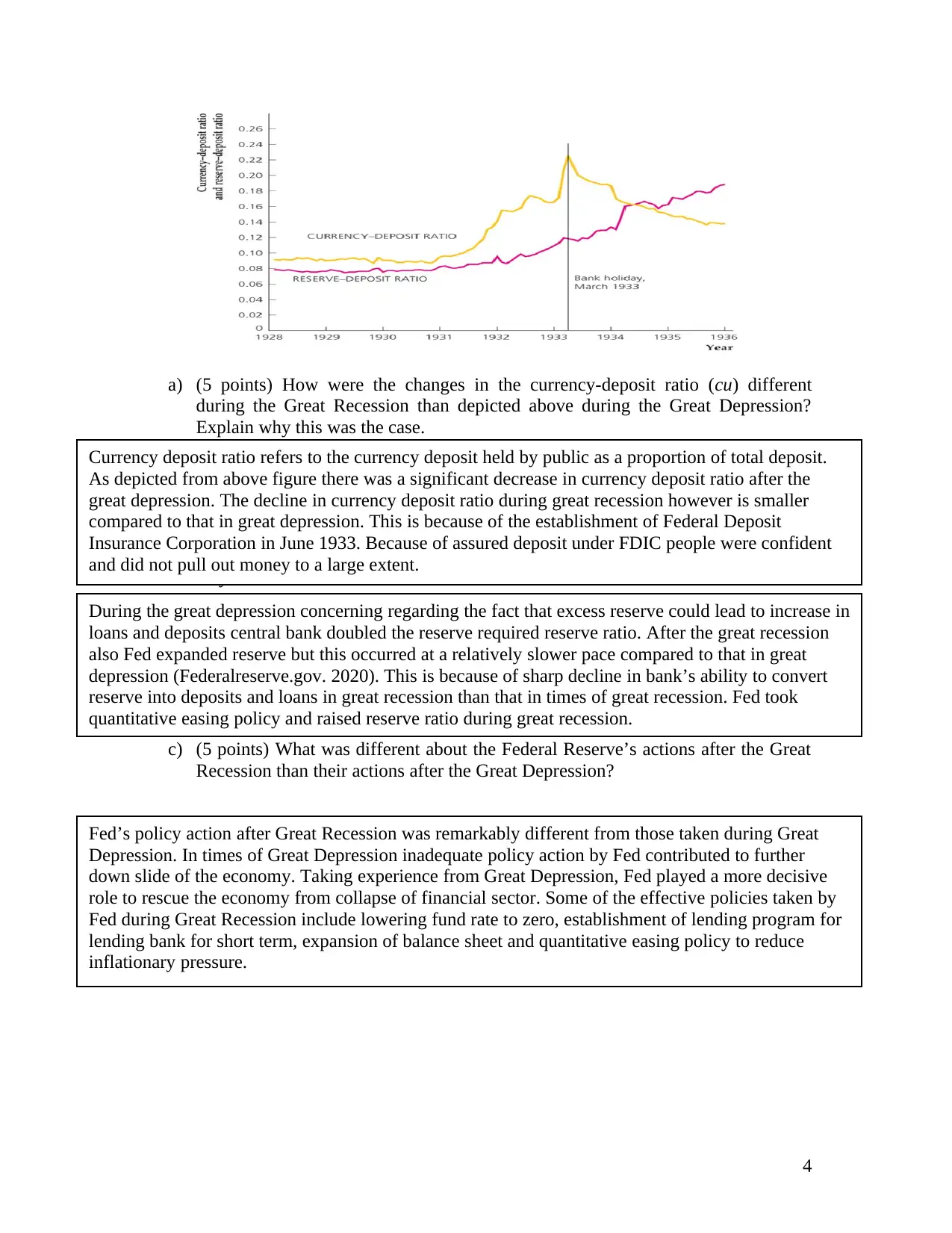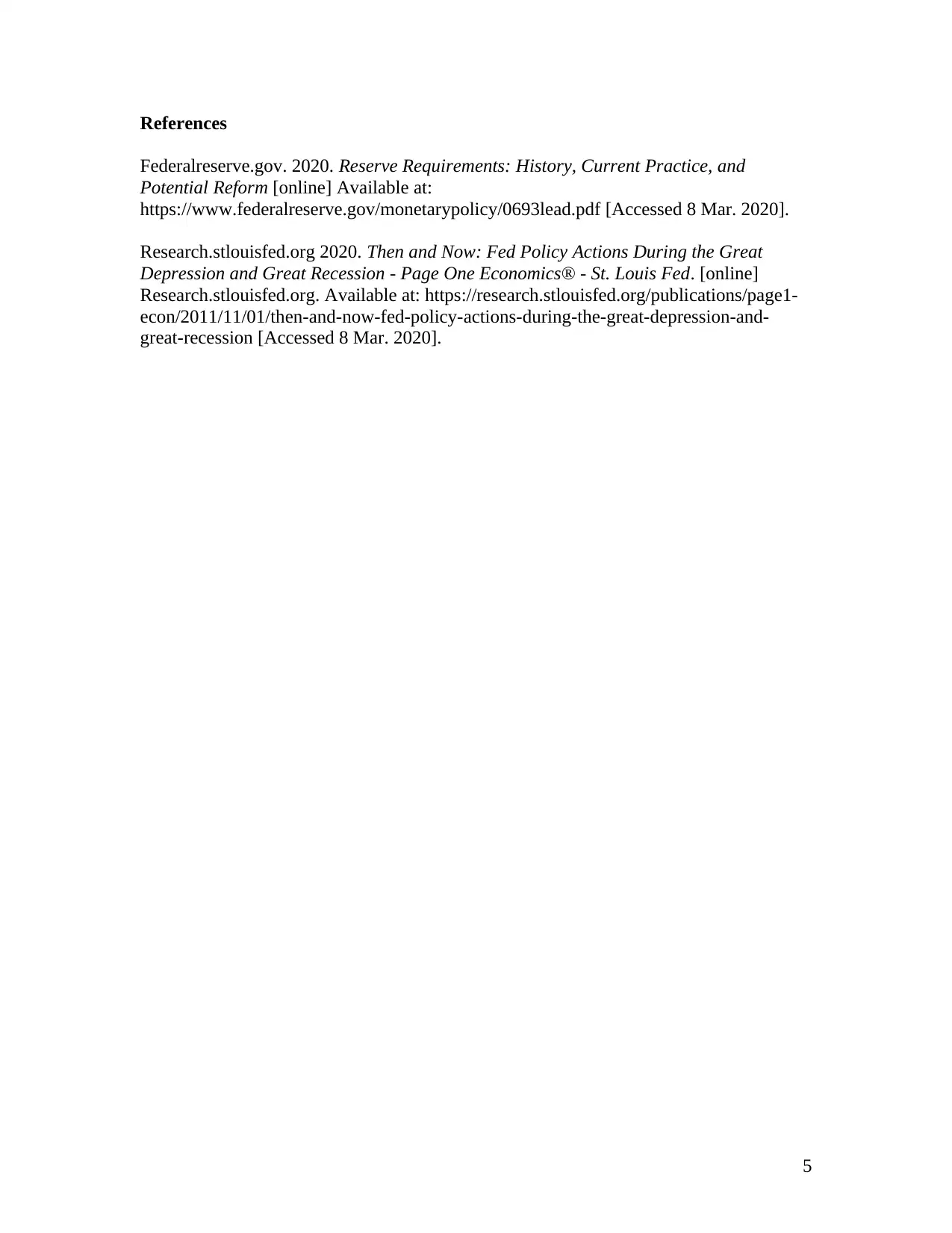Economics 304WD Homework: Analyzing The Fed and the Money Supply
VerifiedAdded on 2022/08/20
|5
|1230
|15
Homework Assignment
AI Summary
This Economics 304WD homework assignment focuses on the money supply and the role of the Federal Reserve. It begins with calculating the money multiplier using the 'more realistic' equation and analyzing the monetary base, money supply, and various ratios given specific economic data. The assignment then explores the impact of a shock on bank reserves, recalculating the money multiplier and money supply under new conditions. Further, it requires a definition of a liquidity trap and a discussion of the Fed's policy responses. The assignment also includes an analysis of the currency-deposit ratio and reserve-deposit ratio during the Great Depression and Great Recession, contrasting the Fed's actions during these periods and drawing on textbook references for context.

Name _________________________________ Date_________ last 4 PSU ID _______
Economics 304WD -- Homework - Lesson 7 - The Fed and the Money Supply 80 pts
You need to show your work, not just the final answer
Use the template to complete your work or points will be taken off.
Be sure your assignment is all on one file. Failure to submit a single file will
result in points being deducted
1. (5 points) What is the equation for the ‘more realistic’ money multiplier?
Money Multiplier = (1+C/D)/ (C/D)+(R/D)
2. In the economy, the following statistics describe the money supply:
C = $1,250b
R = $125b
D = $1,500b
Given these data, calculate the following to whole numbers unless noted otherwise:
a) (5 points) Monetary Base (BASE):
Monetary Base = C + R = $1250+$125= $1375
BASE =
b) (5 points) Money Supply (M):
M/MB = C+D/C+R
Or, M/1375 = (1250+1500)/(1250+125)
Or, M/1375= 2750/1375
Or, M = 2750
M =
c) (5 points) Ratio of reserves to deposits (res): (carry out to four decimals)
R/D = 125/1500
Or, R/D = 0.0833 res =
1
1375
2750
0.0833
Economics 304WD -- Homework - Lesson 7 - The Fed and the Money Supply 80 pts
You need to show your work, not just the final answer
Use the template to complete your work or points will be taken off.
Be sure your assignment is all on one file. Failure to submit a single file will
result in points being deducted
1. (5 points) What is the equation for the ‘more realistic’ money multiplier?
Money Multiplier = (1+C/D)/ (C/D)+(R/D)
2. In the economy, the following statistics describe the money supply:
C = $1,250b
R = $125b
D = $1,500b
Given these data, calculate the following to whole numbers unless noted otherwise:
a) (5 points) Monetary Base (BASE):
Monetary Base = C + R = $1250+$125= $1375
BASE =
b) (5 points) Money Supply (M):
M/MB = C+D/C+R
Or, M/1375 = (1250+1500)/(1250+125)
Or, M/1375= 2750/1375
Or, M = 2750
M =
c) (5 points) Ratio of reserves to deposits (res): (carry out to four decimals)
R/D = 125/1500
Or, R/D = 0.0833 res =
1
1375
2750
0.0833
Paraphrase This Document
Need a fresh take? Get an instant paraphrase of this document with our AI Paraphraser

d) (5points) Ratio of currency to deposits (cu): (carry out to four decimals)
CU = C/D =1250/1500
cu =
e) (5 points) Money Multiplier (mm): (carry out to four decimals)
Mm = 1+c/r+c
=1+0.8333/(0.0833+0.8333)
= 1.8333/0.9166
= 2.0001
mm =
Now suppose a shock causes banks to change the amount of reserves they hold relative to
deposits so that res changes to 0.0694. Suppose that when this happens, both cu and
BASE do not change. However, the change in res will affects mm, M, C, R, and D.
Calculate the following:
a) (5 points) Money Multiplier (mm): (carry out to four decimals)
mm =
mm= (1+0.8333)/(0.0694+0.8333)
= 1.8333/0.9027
= 2.0309
f) (5 points) Money Supply (M):
M = mm * Base
= 2.0309*1375
= 2792
M =
g) (5 points) Bank Deposits (D):
R/D = 0.0694
Or, R = 0.0694D
C/D = 0.8333
Or, C = 0.8333D
M = C + R
Or, 2792 = 0.0694D + 0.8333 D
2
0.8333
2.0001
2.0309
2792
CU = C/D =1250/1500
cu =
e) (5 points) Money Multiplier (mm): (carry out to four decimals)
Mm = 1+c/r+c
=1+0.8333/(0.0833+0.8333)
= 1.8333/0.9166
= 2.0001
mm =
Now suppose a shock causes banks to change the amount of reserves they hold relative to
deposits so that res changes to 0.0694. Suppose that when this happens, both cu and
BASE do not change. However, the change in res will affects mm, M, C, R, and D.
Calculate the following:
a) (5 points) Money Multiplier (mm): (carry out to four decimals)
mm =
mm= (1+0.8333)/(0.0694+0.8333)
= 1.8333/0.9027
= 2.0309
f) (5 points) Money Supply (M):
M = mm * Base
= 2.0309*1375
= 2792
M =
g) (5 points) Bank Deposits (D):
R/D = 0.0694
Or, R = 0.0694D
C/D = 0.8333
Or, C = 0.8333D
M = C + R
Or, 2792 = 0.0694D + 0.8333 D
2
0.8333
2.0001
2.0309
2792

Solving for D,
D = 2792/0.9027
Or, D = 3093
D =
h) (5 points) Currency held by the public (C):
C =
i) (5 points) Bank Reserves (R):
R =
3. (10) What is a liquidity trap? What were the three unusual policies measures from
2009 to 2012 the Fed undertook to get the US economy out of the liquidity trap?
4. From your textbook:
Just as banking panics led to a decline in the money multiplier during the Great
Depression, a worldwide financial panic similarly caused the money multiplier to decline
in 2008.
Below you will find a graph of the currency-deposit ratio (cu) and the reserve-deposit
ratio (dep) from the Great Depression.
3
3093
2577
215
Liquidity trap refers to the situation where the economy is trapped under the condition of high saving
rate and very low interest rate making monetary policy completely ineffective. Central bank during
this time are unable to increase supply of money since any amount of money that central bank can
issue is either held by public or held by banks restricting ability of central bank to increase money
supply. This in turn leads to no further changes in the interest rate or in the additional spending. The
three unusual policy measures taken by Fed to rescue US economy from liquidity trap include
altering expectation about interest rate, expansion of balance sheet size of central bank and variation
in the composition of central bank’s asset (Research.stlouisfed.org 2020).
D = 2792/0.9027
Or, D = 3093
D =
h) (5 points) Currency held by the public (C):
C =
i) (5 points) Bank Reserves (R):
R =
3. (10) What is a liquidity trap? What were the three unusual policies measures from
2009 to 2012 the Fed undertook to get the US economy out of the liquidity trap?
4. From your textbook:
Just as banking panics led to a decline in the money multiplier during the Great
Depression, a worldwide financial panic similarly caused the money multiplier to decline
in 2008.
Below you will find a graph of the currency-deposit ratio (cu) and the reserve-deposit
ratio (dep) from the Great Depression.
3
3093
2577
215
Liquidity trap refers to the situation where the economy is trapped under the condition of high saving
rate and very low interest rate making monetary policy completely ineffective. Central bank during
this time are unable to increase supply of money since any amount of money that central bank can
issue is either held by public or held by banks restricting ability of central bank to increase money
supply. This in turn leads to no further changes in the interest rate or in the additional spending. The
three unusual policy measures taken by Fed to rescue US economy from liquidity trap include
altering expectation about interest rate, expansion of balance sheet size of central bank and variation
in the composition of central bank’s asset (Research.stlouisfed.org 2020).
⊘ This is a preview!⊘
Do you want full access?
Subscribe today to unlock all pages.

Trusted by 1+ million students worldwide

a) (5 points) How were the changes in the currency-deposit ratio (cu) different
during the Great Recession than depicted above during the Great Depression?
Explain why this was the case.
b) (5 points) How were the changes in the reserve-deposit ratio (res) different during
the Great Recession than depicted above during the Great Depression? Explain
why this was the case.
c) (5 points) What was different about the Federal Reserve’s actions after the Great
Recession than their actions after the Great Depression?
4
Currency deposit ratio refers to the currency deposit held by public as a proportion of total deposit.
As depicted from above figure there was a significant decrease in currency deposit ratio after the
great depression. The decline in currency deposit ratio during great recession however is smaller
compared to that in great depression. This is because of the establishment of Federal Deposit
Insurance Corporation in June 1933. Because of assured deposit under FDIC people were confident
and did not pull out money to a large extent.
During the great depression concerning regarding the fact that excess reserve could lead to increase in
loans and deposits central bank doubled the reserve required reserve ratio. After the great recession
also Fed expanded reserve but this occurred at a relatively slower pace compared to that in great
depression (Federalreserve.gov. 2020). This is because of sharp decline in bank’s ability to convert
reserve into deposits and loans in great recession than that in times of great recession. Fed took
quantitative easing policy and raised reserve ratio during great recession.
Fed’s policy action after Great Recession was remarkably different from those taken during Great
Depression. In times of Great Depression inadequate policy action by Fed contributed to further
down slide of the economy. Taking experience from Great Depression, Fed played a more decisive
role to rescue the economy from collapse of financial sector. Some of the effective policies taken by
Fed during Great Recession include lowering fund rate to zero, establishment of lending program for
lending bank for short term, expansion of balance sheet and quantitative easing policy to reduce
inflationary pressure.
during the Great Recession than depicted above during the Great Depression?
Explain why this was the case.
b) (5 points) How were the changes in the reserve-deposit ratio (res) different during
the Great Recession than depicted above during the Great Depression? Explain
why this was the case.
c) (5 points) What was different about the Federal Reserve’s actions after the Great
Recession than their actions after the Great Depression?
4
Currency deposit ratio refers to the currency deposit held by public as a proportion of total deposit.
As depicted from above figure there was a significant decrease in currency deposit ratio after the
great depression. The decline in currency deposit ratio during great recession however is smaller
compared to that in great depression. This is because of the establishment of Federal Deposit
Insurance Corporation in June 1933. Because of assured deposit under FDIC people were confident
and did not pull out money to a large extent.
During the great depression concerning regarding the fact that excess reserve could lead to increase in
loans and deposits central bank doubled the reserve required reserve ratio. After the great recession
also Fed expanded reserve but this occurred at a relatively slower pace compared to that in great
depression (Federalreserve.gov. 2020). This is because of sharp decline in bank’s ability to convert
reserve into deposits and loans in great recession than that in times of great recession. Fed took
quantitative easing policy and raised reserve ratio during great recession.
Fed’s policy action after Great Recession was remarkably different from those taken during Great
Depression. In times of Great Depression inadequate policy action by Fed contributed to further
down slide of the economy. Taking experience from Great Depression, Fed played a more decisive
role to rescue the economy from collapse of financial sector. Some of the effective policies taken by
Fed during Great Recession include lowering fund rate to zero, establishment of lending program for
lending bank for short term, expansion of balance sheet and quantitative easing policy to reduce
inflationary pressure.
Paraphrase This Document
Need a fresh take? Get an instant paraphrase of this document with our AI Paraphraser

References
Federalreserve.gov. 2020. Reserve Requirements: History, Current Practice, and
Potential Reform [online] Available at:
https://www.federalreserve.gov/monetarypolicy/0693lead.pdf [Accessed 8 Mar. 2020].
Research.stlouisfed.org 2020. Then and Now: Fed Policy Actions During the Great
Depression and Great Recession - Page One Economics® - St. Louis Fed. [online]
Research.stlouisfed.org. Available at: https://research.stlouisfed.org/publications/page1-
econ/2011/11/01/then-and-now-fed-policy-actions-during-the-great-depression-and-
great-recession [Accessed 8 Mar. 2020].
5
Federalreserve.gov. 2020. Reserve Requirements: History, Current Practice, and
Potential Reform [online] Available at:
https://www.federalreserve.gov/monetarypolicy/0693lead.pdf [Accessed 8 Mar. 2020].
Research.stlouisfed.org 2020. Then and Now: Fed Policy Actions During the Great
Depression and Great Recession - Page One Economics® - St. Louis Fed. [online]
Research.stlouisfed.org. Available at: https://research.stlouisfed.org/publications/page1-
econ/2011/11/01/then-and-now-fed-policy-actions-during-the-great-depression-and-
great-recession [Accessed 8 Mar. 2020].
5
1 out of 5
Your All-in-One AI-Powered Toolkit for Academic Success.
+13062052269
info@desklib.com
Available 24*7 on WhatsApp / Email
![[object Object]](/_next/static/media/star-bottom.7253800d.svg)
Unlock your academic potential
Copyright © 2020–2025 A2Z Services. All Rights Reserved. Developed and managed by ZUCOL.

